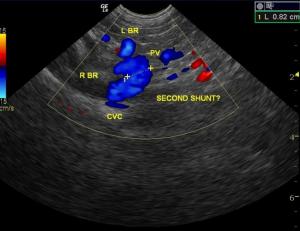The Hunt For The Shunt; SonoPath LOVES the shunt hunt as well as all presentations in vet medicine but our probe is our motor and helping our peeps find shunts is one of our specialties….virtually. Crazy you say? Find a shunt with virtual help? Not really... we do it all the time and have archived tons. In fact, we have created the SonoPath Shunt Club: SonoPath telemedicine clients that have consistently diagnosed shunts by sonogram in the field with our virtual support.
Do you have what it takes to join SonoPath on the inside? Become a member download our brand new cool SonoPath mobile app and run with your medicine +/- sonography curve. If you are a vet, GP or specialist, vet tech wanting to support your doctors then SonoPath will change your diagnostic mojo for the better. Additionally, if you meet our criteria to become a telemedicine client, we will help you reach new levels you may have not thought possible in your scanning abilities. We do telemedicine differently than the rest but that's a secret only to be revealed to members. See what they have to say by clicking here. Helping you find shunts is just a minor example of what we have been able to do remotely and with assistance with on site instruction. For more information email us at info@sonopath.com
Clinical Differential Diagnosis
Cholangitis, hepatitis or cholangiohepatitis with a possible mucocele , previously undiagnosed portosytemic shunt causing decreased cholesterol and urea production. A low creatinine concentration may be due to poor body condition, neoplasia of the liver (primary vs. metastatic; hepatocellular adenoma, lymphoma, adenocarcinoma, leiomyoma, leiomyosarcoma, mast cell tumor, histiocytic sarcoma, etc.) pancreatic neoplasia (adenocarcinoma,) intestinal neoplasia (lymphoma, adenocarcinoma, leiomyoma, leiomyosarcoma, mast cell tumor, histiocytic sarcoma, etc.)
Image Interpretation
The urinary bladder, presented approximately 3-6 shadowing small calculi measuring approximately 0.3cm each. The bladder wall was structurally normal. The liver presented mild subnormal size. The parenchyma was uniform with no significant evidence of structural disease, however the liver presented mildly poor vascularity. The gallbladder was mildly prominent. The portal vein at the portal hilus measured 0.45cm. However a 0.6cm portocaval (splenocaval) shunt cranial to the right kidney was present. The portal vein prior to the shunt deviation was 0.7cm. The shunt itself was 0.65cm and appeared to be portocaval in nature given that the vena cava at the portal hilus measured approximately 1.1cm with the aorta at 0.7cm. There appeared to be a possible second connection in an intrahepatic position between the right branch of the portal vein and the caudal vena cava, however this could not be overtly confirmed by ultrasound and this should be investigated at the time of surgery.
Sonographic Differential Diagnosis
Portacaval (splenocaval) shunt extra hepatic. Concurrent urinary bladder calculi.
Sampling
The patient was referred to a board certified surgeon and an exploratory laparotomy was performed. A PSS was confirmed at surgery and ameroid constrictor placed. The liver biopsy performed showed concurrent microvascular dysplasia.
DX
Portosystemic shunt splenocaval shunt
Outcome
The patient responded well to surgical intervention and post op management with L/D diet and lactulose therapy. Bile acids remained elevated at pre 30/post83 umol/L at a 5 month follow-up. The follow up ultrasound was unremarkable with no bladder calculi formation and the patient was clinically stable.




Comments